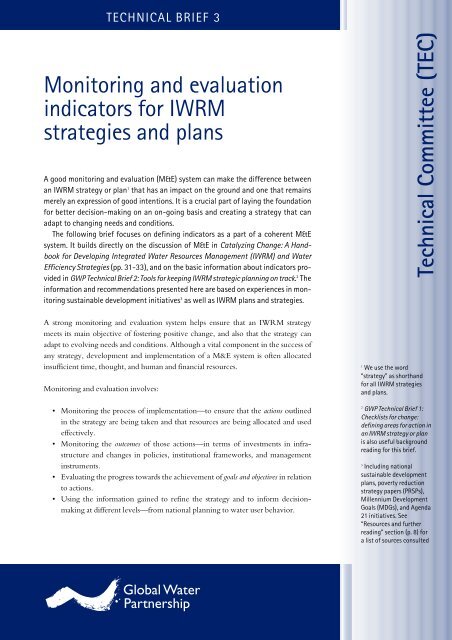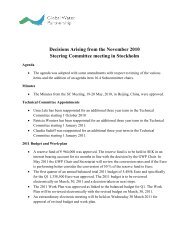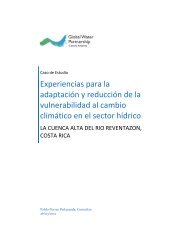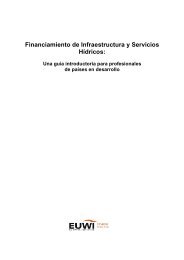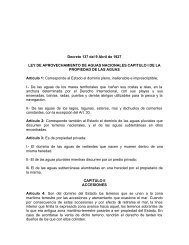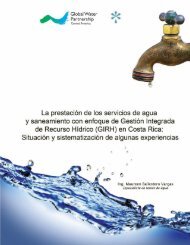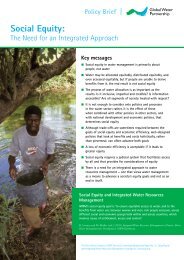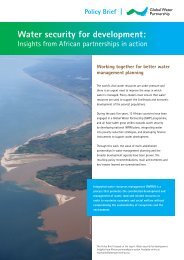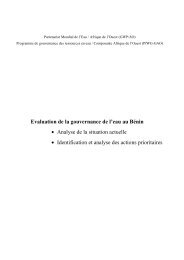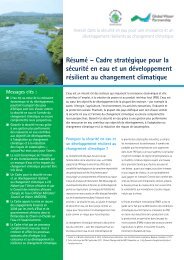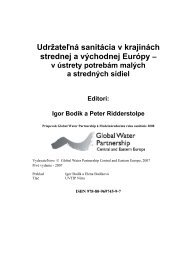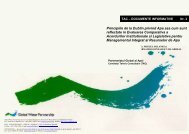Monitoring and evaluation indicators for IWRM strategies and plans
Monitoring and evaluation indicators for IWRM strategies and plans
Monitoring and evaluation indicators for IWRM strategies and plans
You also want an ePaper? Increase the reach of your titles
YUMPU automatically turns print PDFs into web optimized ePapers that Google loves.
TECHNICAL BRIEF 3<br />
<strong>Monitoring</strong> <strong>and</strong> <strong>evaluation</strong><br />
<strong>indicators</strong> <strong>for</strong> <strong>IWRM</strong><br />
<strong>strategies</strong> <strong>and</strong> <strong>plans</strong><br />
A good monitoring <strong>and</strong> <strong>evaluation</strong> (M&E) system can make the difference between<br />
an <strong>IWRM</strong> strategy or plan 1 that has an impact on the ground <strong>and</strong> one that remains<br />
merely an expression of good intentions. It is a crucial part of laying the foundation<br />
<strong>for</strong> better decision-making on an on-going basis <strong>and</strong> creating a strategy that can<br />
adapt to changing needs <strong>and</strong> conditions.<br />
The following brief focuses on defining <strong>indicators</strong> as a part of a coherent M&E<br />
system. It builds directly on the discussion of M&E in Catalyzing Change: A H<strong>and</strong>book<br />
<strong>for</strong> Developing Integrated Water Resources Management (<strong>IWRM</strong>) <strong>and</strong> Water<br />
Efficiency Strategies (pp. 31-33), <strong>and</strong> on the basic in<strong>for</strong>mation about <strong>indicators</strong> provided<br />
in GWP Technical Brief 2: Tools <strong>for</strong> keeping <strong>IWRM</strong> strategic planning on track. 2 The<br />
in<strong>for</strong>mation <strong>and</strong> recommendations presented here are based on experiences in monitoring<br />
sustainable development initiatives 3 as well as <strong>IWRM</strong> <strong>plans</strong> <strong>and</strong> <strong>strategies</strong>.<br />
A strong monitoring <strong>and</strong> <strong>evaluation</strong> system helps ensure that an <strong>IWRM</strong> strategy<br />
meets its main objective of fostering positive change, <strong>and</strong> also that the strategy can<br />
adapt to evolving needs <strong>and</strong> conditions. Although a vital component in the success of<br />
any strategy, development <strong>and</strong> implementation of a M&E system is often allocated<br />
insufficient time, thought, <strong>and</strong> human <strong>and</strong> financial resources.<br />
<strong>Monitoring</strong> <strong>and</strong> <strong>evaluation</strong> involves:<br />
• <strong>Monitoring</strong> the process of implementation—to ensure that the actions outlined<br />
in the strategy are being taken <strong>and</strong> that resources are being allocated <strong>and</strong> used<br />
effectively.<br />
• <strong>Monitoring</strong> the outcomes of those actions—in terms of investments in infrastructure<br />
<strong>and</strong> changes in policies, institutional frameworks, <strong>and</strong> management<br />
instruments.<br />
• Evaluating the progress towards the achievement of goals <strong>and</strong> objectives in relation<br />
to actions.<br />
• Using the in<strong>for</strong>mation gained to refine the strategy <strong>and</strong> to in<strong>for</strong>m decisionmaking<br />
at different levels—from national planning to water user behavior.<br />
Technical Committee (TEC)<br />
1<br />
We use the word<br />
“strategy” as shorth<strong>and</strong><br />
<strong>for</strong> all <strong>IWRM</strong> <strong>strategies</strong><br />
<strong>and</strong> <strong>plans</strong>.<br />
2<br />
GWP Technical Brief 1:<br />
Checklists <strong>for</strong> change:<br />
defining areas <strong>for</strong> action in<br />
an <strong>IWRM</strong> strategy or plan<br />
is also useful background<br />
reading <strong>for</strong> this brief.<br />
3<br />
Including national<br />
sustainable development<br />
<strong>plans</strong>, poverty reduction<br />
strategy papers (PRSPs),<br />
Millennium Development<br />
Goals (MDGs), <strong>and</strong> Agenda<br />
21 initiatives. See<br />
“Resources <strong>and</strong> further<br />
reading” section (p. 8) <strong>for</strong><br />
a list of sources consulted
Box 1: Common pitfalls in developing an M&E system<br />
• Not having a system: Defining a loose collection of disparate <strong>indicators</strong> with little or no relationship to each<br />
other, instead of a system in which <strong>indicators</strong> relate to each other <strong>and</strong> to the strategy goals, objectives <strong>and</strong> targets<br />
in a meaningful way.<br />
• Bad fit between targets <strong>and</strong> <strong>indicators</strong>: Defining <strong>indicators</strong> with a weak relationship to the targets set <strong>for</strong> strategy<br />
activities, objectives <strong>and</strong> goals. In most cases, the problem is with the indicator; in others, the root of the<br />
problem is a poorly <strong>for</strong>mulated target.<br />
• Building a system based on bad baseline data <strong>and</strong>/or unreliable <strong>indicators</strong>: Indicators need to provide a consistent<br />
measure of progress. This means that the starting point (the baseline data) is accurate <strong>and</strong> that the indicator<br />
provides an objectively verifiable result, i.e. two people applying the same indicator should get the same result.<br />
• Not taking into account that impacts may differ according to location <strong>and</strong> to the gender <strong>and</strong> socio-economic<br />
status of intended beneficiaries.<br />
• Poor feedback mechanisms: Developing a system in which indicator results do not feed back into the strategy<br />
process <strong>and</strong> into decision-making <strong>and</strong> planning processes. M&E systems are worthless if the in<strong>for</strong>mation they<br />
provide is not acted upon.<br />
“<br />
Indicators can help<br />
to answer the questions<br />
where are we<br />
now, where do we<br />
want to go, are we<br />
taking the right path<br />
to get there, <strong>and</strong> are<br />
we there yet?<br />
An overview of the roles <strong>indicators</strong> play in the strategy process<br />
Indicators are the basic building blocks of monitoring <strong>and</strong> <strong>evaluation</strong> systems. They are<br />
also a part of assessment, which plays a crucial role at the beginning of the strategy <strong>for</strong>mulation<br />
process <strong>and</strong> provides the baseline needed <strong>for</strong> M&E during implementation.<br />
As a part of assessment <strong>and</strong> M&E systems, <strong>indicators</strong> help to answer key questions at<br />
various stages in the strategy, such as where are we now, where do we want to go, are we<br />
taking the right path to get there, <strong>and</strong>, finally, are we there yet?<br />
Where are we now? As part of a baseline assessment at the beginning of the strategy<br />
process, <strong>indicators</strong> help to determine what the problems are, where they are, <strong>and</strong> their<br />
level of severity. Depending on the resources available <strong>and</strong> the strategy approach chosen,<br />
this may be through a comprehensive assessment of water resource requirements <strong>and</strong><br />
availabilities, or through a more targeted assessment focused on specific problem areas<br />
that have already been identified. Some of these <strong>indicators</strong> will feed into the monitoring<br />
<strong>and</strong> <strong>evaluation</strong> system—providing a baseline against which to measure progress during<br />
implementation. These might include <strong>indicators</strong> of water availability, water quality, irrigation<br />
per<strong>for</strong>mance, aquatic ecosystem health, incidence of water-borne disease, incidence<br />
<strong>and</strong> impacts of flood or drought, <strong>and</strong> access to water supply <strong>and</strong> sanitation. They<br />
may also include sustainable development <strong>indicators</strong> that are not as clearly water-related<br />
such as child mortality, percentage of boys <strong>and</strong> girls in rural areas attending school, <strong>and</strong><br />
changes in the contribution of certain sectors to the GNP.<br />
Where do we want to go? In<strong>for</strong>mation provided by the baseline assessment <strong>indicators</strong><br />
can help decide on priorities <strong>and</strong> can serve as a useful input into stakeholder dialogues<br />
during the strategy <strong>for</strong>mulation process. Indicators may also be used in identifying the<br />
necessary actions by helping to assess the effectiveness of existing institutions, policies,<br />
regulations, etc. (See Technical Brief 1). Once priorities <strong>and</strong> basic goals, objectives, <strong>and</strong><br />
actions have been agreed upon, the process of defining <strong>indicators</strong> <strong>for</strong> monitoring <strong>and</strong><br />
<strong>evaluation</strong> can help to set <strong>and</strong> refine specific targets.<br />
2
Are we taking the right path to get there? As part of an M&E system, <strong>indicators</strong> can<br />
signal when a strategy is off track—when actions are not being taken or are not resulting<br />
in the desired outcomes <strong>and</strong> impacts. At the day-to-day project management level, <strong>indicators</strong><br />
can be used to track inputs—are the human <strong>and</strong> financial resources allocated to different<br />
activities adequate <strong>and</strong> are those resources being disbursed <strong>and</strong> used efficiently? (See<br />
Technical Brief 2 <strong>for</strong> more in<strong>for</strong>mation on the role of <strong>indicators</strong> in project management.)<br />
Are we there yet? Evaluating progress towards goals <strong>and</strong> objectives is important not just<br />
from the st<strong>and</strong>point of identifying when <strong>and</strong> where adjustments are needed but also <strong>for</strong><br />
the purpose of accountability <strong>and</strong> building <strong>and</strong> maintaining support <strong>for</strong> the strategy.<br />
Box 2: Definitions<br />
The terminology used in M&E is still far from st<strong>and</strong>ardized, resulting in a confused tangle of competing definitions.<br />
Below we’ve defined the terms used in this brief. These are in accord with the framework employed in<br />
monitoring the Millennium Development Goals <strong>and</strong> with the most common logical framework definitions.<br />
• Goals are broad, qualitative statements about what is to be achieved or what problem is to be solved. For<br />
example, Millennium Development Goal 1 is to eradicate extreme poverty <strong>and</strong> hunger. In the case of an<br />
<strong>IWRM</strong> strategy or plan, using already accepted national <strong>and</strong> international goals is one way of linking into<br />
larger sustainable development <strong>and</strong> poverty initiatives, such as ef<strong>for</strong>ts to meet MDGs, national sustainable<br />
development <strong>plans</strong>, etc.<br />
• Objectives are the means identified to achieve goals, or the major water <strong>and</strong> development challenges that<br />
need to be overcome to achieve the goals. For example, reducing farmers’ vulnerability to drought in rainfed<br />
areas might be an objective associated with the goal of eradicating extreme poverty <strong>and</strong> hunger. (The<br />
Millennium Declaration does not define objectives, since they will differ from country to country.) Often<br />
the terms “goals” <strong>and</strong> “objectives” are used interchangeably. Here we chose to make the distinction<br />
between “goals”, as overarching aims, often defined by larger national (<strong>and</strong> international) priorities, <strong>and</strong><br />
“objectives”, as specific aims to be achieved that are determined by the goals.<br />
• Actions are the specific activities identified to accomplish objectives. These encompass infrastructural<br />
development <strong>and</strong> changes in policies, institutions, <strong>and</strong> management instruments.<br />
All the above goals, objectives <strong>and</strong> actions have corresponding targets <strong>and</strong> <strong>indicators</strong>:<br />
• Targets make goals, objectives <strong>and</strong> actions specific with defined <strong>and</strong> measurable criteria <strong>for</strong> achievement<br />
<strong>and</strong> timetables. For MDG 1, one of the targets is to halve, between 1990 <strong>and</strong> 2015, the proportion of people<br />
who suffer from hunger.<br />
• Indicators are measures selected to assess progress towards the targets associated with goals <strong>and</strong> objectives<br />
<strong>and</strong> the accomplishment of actions. For example, the prevalence of underweight children under five years<br />
of age <strong>and</strong> the proportion of population below the minimum level of dietary energy consumption are used<br />
as <strong>indicators</strong> <strong>for</strong> the Millennium Development target on hunger.<br />
Indicators can be further subdivided into:<br />
• Process <strong>indicators</strong>, which monitor the basic progress of implementing the actions outlined in the strategy.<br />
This includes monitoring implementation processes <strong>and</strong> also the tracking of inputs—the people, money,<br />
equipment needed to achieve actions.<br />
• Outcome <strong>indicators</strong>, which monitor the direct results of actions. (Sometimes used interchangeably with<br />
impact <strong>indicators</strong>.)<br />
• Impact <strong>indicators</strong>, which monitor progress towards achieving goals <strong>and</strong> objectives.<br />
3
“<br />
A good monitoring<br />
<strong>and</strong> <strong>evaluation</strong> system<br />
will also take<br />
into account possible<br />
tradeoffs <strong>and</strong><br />
unintended consequences<br />
involved in<br />
any course of action.<br />
The challenge of linking actions, outcomes <strong>and</strong> impacts<br />
As suggested in the preceding section, decisions on what <strong>and</strong> even how to monitor cannot<br />
be made independently from the definition of goals, objectives, actions <strong>and</strong> targets, all<br />
of which should relate to each other in a logical way. Establishing these logical relationships<br />
is a large part of developing an effective M&E system, as well as an effective strategy.<br />
In particular, establishing cause-effect relationships between the outcomes of actions—<br />
the direct results of the strategy’s activities—<strong>and</strong> impacts, in terms of the strategy’s larger<br />
goals <strong>and</strong> objectives, can be difficult. This is partially because impacts take time to<br />
emerge, but also because progress on the ground can rarely be attributed to a single cause.<br />
Usually it is the product of multiple <strong>for</strong>ces—not all of which lie within the strategy’s<br />
scope of action—which are often too numerous <strong>and</strong>/or complex to feasibly monitor.<br />
That said, there are ways around this dilemma: (1) making initial assumptions regarding<br />
causal links explicit <strong>and</strong> regarding these as hypotheses that the M&E system will test; (2)<br />
identifying factors outside the strategy that could influence impacts <strong>and</strong> choosing which<br />
ones to monitor based on the likelihood <strong>and</strong> potential degree of influence; (3) setting <strong>and</strong><br />
monitoring short-, medium-, <strong>and</strong> long-term targets; <strong>and</strong>, most importantly, (4) developing<br />
an M&E system that is geared towards learning <strong>and</strong> adaptation.<br />
Defining the links in the chain: In monitoring <strong>and</strong> <strong>evaluation</strong> it is important to develop<br />
<strong>indicators</strong> to monitor all the key links in a chain of results or logical hierarchy. To take<br />
a relatively simple example at a sub-national level, let us say that the goal is to improve the<br />
livelihoods of fishers in a coastal ecosystem. One of the objectives that has been identified<br />
under this goal is to reduce the high levels of pesticides in the river feeding the ecosystem,<br />
based on the assumption that high pesticide levels are having a negative impact on the<br />
catches of the area fishers. The primary action identified to address this problem is to<br />
introduce an integrated pest management program in the upstream agricultural area.<br />
There would need to be <strong>indicators</strong> to track (1) if the action was resulting in a reduction in<br />
pesticide use by farmers, (2) if the changes in farmer behavior were resulting in a significant<br />
reduction in the pesticide levels in the river, <strong>and</strong> (3) if this improved water quality<br />
was resulting in improved catches <strong>and</strong> increased income <strong>for</strong> the fishers. Without developing<br />
<strong>and</strong> analyzing <strong>indicators</strong> together in the context of a logical chain of results, it is difficult<br />
to identify the problem when goals <strong>and</strong> objectives aren’t reached.<br />
A good monitoring <strong>and</strong> <strong>evaluation</strong> system will also take into account possible tradeoffs<br />
<strong>and</strong> unintended consequences involved in any course of action. To continue with the<br />
above example, this would also mean monitoring agricultural productivity in the<br />
upstream area where integrated pest management was introduced to make sure that there<br />
was not a resulting decline in crop yields. It might also mean monitoring the market price<br />
of fish, to make sure that increasing the fishers’ catches doesn’t result in a glut in the market<br />
<strong>and</strong> a corresponding drop in prices.<br />
The way in which <strong>indicators</strong> at different levels interconnect is depicted in Box 3. The<br />
key point here is that <strong>indicators</strong> cannot be identified in isolation—they must emerge from<br />
agreed goals <strong>and</strong> objectives, <strong>and</strong> the actions needed to achieve them.<br />
Basic steps in developing <strong>indicators</strong> as part of an a M&E system<br />
There are various approaches to defining <strong>indicators</strong>. The model below is one example:<br />
Step 1: Make sure that targets associated with strategy goals, objectives <strong>and</strong> actions are clearly<br />
defined <strong>and</strong> agreed upon; <strong>and</strong> that the inputs necessary carry out actions are identified.<br />
4
Box 3: The relationships between goals, objectives, actions, targets <strong>and</strong> <strong>indicators</strong><br />
The following example defines a hypothetical set of objectives <strong>and</strong> actions, with targets <strong>and</strong> <strong>indicators</strong>, to contribute<br />
to Millennium Development Goal (MDG) 1. The example is intended to illustrate the relationships between these different<br />
elements of an <strong>IWRM</strong> strategy, <strong>and</strong>, in particular, to offer insight into the process of defining targets <strong>and</strong> <strong>indicators</strong>.<br />
It is not intended to be comprehensive nor to serve as a recommendation of any particular objectives or actions.<br />
The <strong>IWRM</strong> strategy or plan may take as<br />
its overarching goal one or more of the<br />
development goals that the country is<br />
committed to achieving <strong>and</strong> that are<br />
impacted, directly or indirectly, by water<br />
resources development, management<br />
<strong>and</strong> use.<br />
In the case of national <strong>and</strong> international<br />
development goals, often targets <strong>and</strong><br />
<strong>indicators</strong> will already have been<br />
defined.<br />
Targets <strong>and</strong> <strong>indicators</strong> defined <strong>for</strong> the<br />
objective should relate clearly to the targets<br />
<strong>and</strong> <strong>indicators</strong> defined <strong>for</strong> the goal.<br />
For example, accomplishment of this<br />
target, as measured by the indicator,<br />
would theoretically contribute directly<br />
to meeting MDG target 1, according to<br />
indicator 1—proportion of population<br />
below $1 per day.<br />
Additional targets would be needed to<br />
address the household water supply <strong>and</strong><br />
sustainability components of the objective.<br />
The <strong>IWRM</strong> strategy or plan needs to<br />
define a set of actions to achieve each<br />
objective—i.e. infrastructural development<br />
investments <strong>and</strong> changes in policies,<br />
institutions <strong>and</strong> management<br />
instruments. This might be one of the<br />
actions under the above objective.<br />
Targets, process <strong>indicators</strong>, <strong>and</strong> outcome<br />
<strong>indicators</strong> need to be defined <strong>for</strong> each<br />
action. Notice that this example<br />
includes short-, medium-, <strong>and</strong> longterm<br />
targets.<br />
Process <strong>indicators</strong>, used to measure the<br />
process of implementing the action, can<br />
be quantitative or qualitative; in some<br />
case a checklist item may be more<br />
appropriate. 2 This example contains a<br />
mix of quantitative <strong>indicators</strong> <strong>and</strong><br />
checklist items<br />
The outcome <strong>indicators</strong> relate directly<br />
to targets set <strong>for</strong> this action. The<br />
assumption behind these targets are<br />
that if the program reaches the farmers,<br />
their incomes will improve. Testing this<br />
involves correlating the results of the<br />
outcome <strong>indicators</strong> with results from<br />
the impact indicator defined <strong>for</strong> the<br />
objective.<br />
GOALS<br />
Example goal:<br />
• Millennium Development Goal #1: Eradicate extreme poverty <strong>and</strong> hunger<br />
Target:<br />
• Target #1: halve, between 1990 <strong>and</strong> 2015, the proportion of people whose income is<br />
less than one dollar a day<br />
• Target#2: halve, between 1990 <strong>and</strong> 2015, the proportion of people who suffer from<br />
hunger<br />
(Impact) Indicators <strong>for</strong> Target #1:<br />
• MDG Indicator #1: Proportion of population below $1 (PPP) per day<br />
• MDG Indicator #2: Poverty gap ratio (incidence x depth of poverty)<br />
• MDG Indicator #3: Share of poorest quintile in national consumption<br />
OBJECTIVES<br />
Example objective:<br />
• Fully <strong>and</strong> sustainably harness rainwater <strong>and</strong> groundwater resources<br />
in the country’s arid <strong>and</strong> semi arid areas to improve the income-generating<br />
potential of small-scale agriculture in those areas <strong>and</strong> provide<br />
improved access to safe water <strong>for</strong> household use<br />
Example of a target:<br />
• Between 2005 <strong>and</strong> 2015, increase average annual income of farmers<br />
with plots of less than 1 hectare by at least $2 per day<br />
Example of an impact indicator:<br />
• Average annual income, by district, of farmers with less than 1 hectare of l<strong>and</strong><br />
Objectives can be thought of as<br />
the major water <strong>and</strong> development<br />
challenges that need to be<br />
addressed to achieve the defined<br />
goals. For a country with many<br />
poor people dependant on marginal<br />
rainfed agriculture, this might<br />
be a possible objective under MDG<br />
1.<br />
Objectives <strong>and</strong> actions will often<br />
contribute to more than one target,<br />
<strong>and</strong> even more than one goal.<br />
The example used here contributes<br />
to MDG 1, targets 1 <strong>and</strong> 2, <strong>and</strong><br />
also to MDG 7, target 9 on integrating<br />
sustainable development<br />
principles into policies <strong>and</strong> programs<br />
<strong>and</strong> target 10 on sustainable<br />
access to safe drinking water<br />
<strong>and</strong> sanitation.<br />
ACTIONS<br />
Example action:<br />
• Create integrated program targeted at farmers with plots less than 1 hectare to promote<br />
sustainable groundwater development <strong>and</strong> rainwater harvesting in combination<br />
with supplemental irrigation<br />
Example targets:<br />
• By 2009, 50% of farmers identified by baseline study are reached by program<br />
• By 2010, at least 80% of farmers identified by baseline study are reached by program<br />
• By 2015, 100% of farmers identified by baseline study are reached by program<br />
• By 2015, total groundwater withdrawal reaches 90% of safe yield 1<br />
Some examples of process <strong>indicators</strong><br />
(unless otherwise noted, these <strong>indicators</strong> are to be applied by district, annually):<br />
• Financial resources allocated to the development <strong>and</strong> implementation of program<br />
• Feasibility/baseline study completed; target districts identified by 2007<br />
• Groundwater assessment <strong>and</strong> monitoring system in place in target districts by 2007<br />
• System <strong>for</strong> regulating <strong>and</strong> licensing groundwater withdrawal put into place by 2007<br />
• Number of check dams sited <strong>and</strong> constructed with community participation<br />
• Percentage of low-interest loans to farmers that are defaulted on<br />
• Number of agricultural extension officers trained in supplemental irrigation <strong>and</strong><br />
water harvesting<br />
Some examples of outcome <strong>indicators</strong>:<br />
• Number of low-interest loans granted <strong>for</strong> investing in supplemental irrigation technologies,<br />
water harvesting, <strong>and</strong> groundwater development (monthly)<br />
• Number of farmers served by extension officers trained in supplemental irrigation<br />
<strong>and</strong> water harvesting<br />
• Number of groundwater licenses granted<br />
• Total groundwater withdrawal expressed as a percentage of safe yield<br />
1 Rate of groundwater extraction from a basin <strong>for</strong> consumptive use over an indefinite period of time that can be maintained without producing negative effects.<br />
2 See Technical Brief 2 of this series <strong>for</strong> in<strong>for</strong>mation on deciding between quantitative <strong>indicators</strong>, qualitative <strong>indicators</strong> or checklist items.<br />
5
Step 2: Define <strong>indicators</strong> <strong>for</strong> each target based on stakeholder consultations <strong>and</strong> on criteria,<br />
such as relevance, reliability, <strong>and</strong> cost-effectiveness. Involve stakeholders who cause or<br />
are affected by the problem or issue addressed in the target; who have relevant in<strong>for</strong>mation<br />
or expertise; <strong>and</strong> who will be responsible <strong>for</strong> implementing <strong>indicators</strong>.<br />
“<br />
Stakeholders to<br />
involve include<br />
those who cause or<br />
are affected by the<br />
problem or issue to<br />
be addressed; those<br />
with relevant in<strong>for</strong>mation<br />
or expertise;<br />
<strong>and</strong> those who will<br />
be responsible <strong>for</strong><br />
implementing<br />
<strong>indicators</strong>.<br />
Step 3: Select <strong>indicators</strong> to track human <strong>and</strong> financial resources <strong>and</strong> ensure that they are being<br />
disbursed <strong>and</strong> used efficiently.<br />
Step 4: Check to make sure that <strong>indicators</strong> relate clearly to targets, <strong>and</strong> that these in turn support<br />
the achievement of actions, objectives <strong>and</strong> goals. Identify <strong>and</strong> fill gaps. Refine <strong>indicators</strong><br />
<strong>and</strong>/or targets as necessary. This step may involve taking an inventory of <strong>indicators</strong><br />
that are already in use in the country to eliminate redundancies, <strong>and</strong> also considering<br />
the relationship of national M&E ef<strong>for</strong>ts to international monitoring programs—such<br />
as the World Water Assessment Programme.<br />
Step 5: Calculate human <strong>and</strong> financial resources needed to apply the indicator package.<br />
Evaluate whether the package is a good investment, i.e. the human <strong>and</strong> financial<br />
resources required are commensurate with the value of the various <strong>indicators</strong><br />
employed.<br />
Step 6: Agree on the agencies/institutions that will be responsible <strong>for</strong> applying the different <strong>indicators</strong>,<br />
how, <strong>and</strong> how often.<br />
Step 7: Determine how the in<strong>for</strong>mation resulting from the different <strong>indicators</strong> will be managed:<br />
how it fits into decision-making processes, both specifically related to the strategy but<br />
also ongoing policy <strong>and</strong> planning processes; how in<strong>for</strong>mation will be amalgamated to<br />
get a more comprehensive picture of progress; <strong>and</strong> how it will be communicated to<br />
stakeholders.<br />
Step 8: Include requirements <strong>for</strong> M&E package in capacity building plan, budget, <strong>and</strong> staff allocation.<br />
Some nuts <strong>and</strong> bolts of establishing an M&E system<br />
Determining frequency of monitoring <strong>and</strong> reporting: Should be based on how<br />
rapidly conditions are changing <strong>and</strong> the significance of change. In general, processes need<br />
to be monitored frequently <strong>and</strong> need to be part of regular management activities. Action<br />
monitoring is generally tied to specific milestones. Objectives have a longer time horizon—depending<br />
on the specific objective, this may mean monthly, quarterly, biannual,<br />
or annual monitoring. Progress on goals may take many years to emerge, this may mean<br />
annual monitoring, but reporting every three years or even every five years—again<br />
depending on the targets defined.<br />
Coordinating monitoring ef<strong>for</strong>ts across agencies (see also Catalyzing Change, pp.<br />
29-31, on building a knowledge base): Creating the kind of M&E system needed <strong>for</strong> an<br />
<strong>IWRM</strong> strategy often involves linking the data collection activities of multiple agencies.<br />
This can be a challenge, especially if agencies are not used to working together, much less<br />
sharing in<strong>for</strong>mation. One possible solution is to create a monitoring <strong>and</strong> <strong>evaluation</strong> unit<br />
or task <strong>for</strong>ce, with representation from organizations <strong>and</strong> agencies carrying out relevant<br />
monitoring activities. Also make sure that agencies underst<strong>and</strong> how the data they provide<br />
is being used <strong>and</strong> that the flow of in<strong>for</strong>mation is not solely one way.<br />
6
Managing data: Investment in designing a good data management system is money well<br />
spent. When considering the design of such a system, consider current needs as well as<br />
future ones. Solicit input from a range of end users of the system.<br />
Communicating with stakeholders: An often neglected aspect of monitoring <strong>and</strong><br />
<strong>evaluation</strong> is communicating results to stakeholders—this includes those directly<br />
involved in implementing the strategy as well as the general public. Regular stakeholder<br />
communication can help to mobilize support <strong>for</strong> the strategy <strong>and</strong> to increase accountability.<br />
Effective communication means packaging in<strong>for</strong>mation in a way that is readily<br />
underst<strong>and</strong>able to the target group <strong>and</strong> that addresses their needs or concerns.<br />
Linking to decision-making <strong>and</strong> planning processes: Part of the on-going work of<br />
the strategy process is to support better decision-making. M&E is a valuable tool in this<br />
ef<strong>for</strong>t—but only if M&E results are provided to decision-makers at all levels in a readily<br />
accessible <strong>for</strong>m that meets the end users’ needs.<br />
Building a system that encourages improvement <strong>and</strong> adaptation<br />
A good monitoring <strong>and</strong> <strong>evaluation</strong> system should support improvement <strong>and</strong> adaptation at<br />
several different levels. At the project management level, a monitoring <strong>and</strong> <strong>evaluation</strong><br />
system should provide in<strong>for</strong>mation needed to improve the efficiency of the implementation<br />
process <strong>and</strong> the per<strong>for</strong>mance of those involved. At a strategic level, it should also support<br />
regular reviews of the strategy itself—to revaluate chosen courses of action <strong>and</strong> take<br />
into account changing contexts. The monitoring <strong>and</strong> <strong>evaluation</strong> system itself should also<br />
be subject to regular reviews.<br />
Key lessons<br />
• Indicators should clearly relate to the targets defined <strong>for</strong> the strategy’s actions,<br />
objectives <strong>and</strong> goals.<br />
• Indicators need to be defined <strong>and</strong> analyzed as part of a logical framework of relationships<br />
between goals, objectives, actions <strong>and</strong> the intended outcomes <strong>and</strong> impacts. In<br />
some cases these relationships may only be hypothesized, in which case part of the<br />
work of the M&E system is to test hypothesized links.<br />
• Stakeholders should be involved in defining <strong>indicators</strong> <strong>and</strong> should clearly see how<br />
the in<strong>for</strong>mation provided by the indicator relates to their concerns <strong>and</strong> activities.<br />
• It should be clear who is responsible <strong>for</strong> applying each indicator <strong>and</strong> how the resulting<br />
in<strong>for</strong>mation will be utilized in the process—who needs it when.<br />
• M&E needs to take into account that impacts may differ according to location <strong>and</strong><br />
gender <strong>and</strong> socio-economic status of beneficiaries.<br />
• The human <strong>and</strong> financial resources required <strong>for</strong> M&E need to be considered <strong>and</strong><br />
factored into budgets <strong>and</strong> capacity-building needs.<br />
• The results of M&E activities should be communicated regularly to stakeholders—<br />
to help mobilize support <strong>for</strong> the strategy <strong>and</strong> to increase accountability.<br />
7
Resources <strong>and</strong> further reading<br />
Booth, D. <strong>and</strong> Lucas, H. (2002). ODI Working Paper 172: Good Practice in the Development of PRSP Indicators<br />
<strong>and</strong> <strong>Monitoring</strong> Systems. http://www.odi.org.uk/publications/working_papers/wp172.pdf<br />
CSD (2001). Indicators of Sustainable Development: Guidelines <strong>and</strong> Methodologies.<br />
http://www.un.org/esa/sustdev/publications/indisd-mg2001.pdf<br />
Dalal-Clayton <strong>and</strong> Bass (2002). Sustainable Development Strategies – A Resource Book. Chapters 5 <strong>and</strong> 10.<br />
http://www.nssd.net/res_book.html<br />
Joint <strong>Monitoring</strong> Programme (JMP) <strong>for</strong> water supply <strong>and</strong> sanitation www.wssinfo.org/<br />
IISD, Measurement <strong>and</strong> assessment <strong>for</strong> sustainable development website http://www.iisd.org/measure/<br />
IRC (2004) <strong>Monitoring</strong> Millennium Development Goals <strong>for</strong> Water <strong>and</strong> Sanitation: A Review of Experiences <strong>and</strong> Challenges.<br />
http://www.irc.nl/page/12932<br />
<strong>IWRM</strong> Toolbox: Tool C1.4 Developing water management <strong>indicators</strong> www.gwp<strong>for</strong>um.org<br />
OECD (2001) The DAC Guidelines: Strategies <strong>for</strong> Sustainable Development.<br />
http://www.oecd.org/dataoecd/34/10/2669958.pdf<br />
Parris, T. <strong>and</strong> Kates, R. (2003) Characterizing <strong>and</strong> Managing Sustainable Development. Annual Review of Environment<br />
<strong>and</strong> Resources vol. 28, pp. 559-86. http://arjournals.annualreviews.org<br />
Swanson, Pintér, et al. (2002) National Strategies <strong>for</strong> Sustainable Development Challenges, Approaches <strong>and</strong> Innovations in<br />
Strategic <strong>and</strong> Co-ordinated Action Based on a 19-country Analysis. Pages 22 – 28.<br />
http://www.iisd.org/publications/pub.aspx?id=640<br />
UN DESA (2002). Guidance in preparing a national sustainable development strategy: Managing sustainable development in<br />
the new millennium. Pages 32 – 34. http://www.un.org/esa/sustdev/natlinfo/nsds/nsds.htm<br />
Walmsley, D., et al. (2004). IWMI Working Paper 90: An Evaluation of Proposed World Water Programme Indicators<br />
<strong>for</strong> Use in South Africa. http://www.iwmi.cgiar.org/pubs/working/WOR90.pdf<br />
Water <strong>Monitoring</strong> Alliance http://www.watermonitoringalliance.net/<br />
Winograd, Manuel, et al. (1999) A Conceptual Framework to Develop <strong>and</strong> Use Water Indicators http://lnweb18.worldbank.org/ESSD/envext.nsf/44ByDocName/ConceptualFrameworktoDevelop<strong>and</strong>UseWaterIndicators199987KP<br />
DF/$FILE/ConceptualFrameworktoDevelop<strong>and</strong>UseWaterIndicators1999.pdf<br />
World Bank, World Development Indicators http://devdata.worldbank.org/wdi2005/index2.htm<br />
World Water Assessment Program http://www.unesco.org/water/wwap/<br />
This brief was written by Sarah Carriger under the direction of the GWP Technical Committee.<br />
It draws on a background note prepared by Hartmut Bruehl <strong>and</strong> on several documents<br />
listed under “resources <strong>and</strong> related reading”. It also benefited from comments by reviewers<br />
Jennifer Davis, Henrik Larson <strong>and</strong> Palle Lindgaard Jørgensen.<br />
About the Catalyzing Change Series<br />
The brief is part of a series of policy <strong>and</strong> technical briefs designed to help countries accelerate<br />
their ef<strong>for</strong>ts to achieve the action target <strong>for</strong> the preparation of <strong>IWRM</strong> <strong>and</strong> water efficiency<br />
<strong>strategies</strong> <strong>and</strong> <strong>plans</strong> set by the 2002 World Summit on Sustainable Development (WSSD) <strong>and</strong><br />
rein<strong>for</strong>ced by the 2005 World Summit. The series tackles key issues <strong>and</strong> potential stumbling<br />
blocks <strong>and</strong> attempts to give countries at the beginning of the process the benefit of lessons<br />
learned from those further down the path.<br />
The series complements Catalyzing Change: A H<strong>and</strong>book <strong>for</strong> Developing Integrated Water<br />
Resources Management (<strong>IWRM</strong>) <strong>and</strong> Water Efficiency Strategies. The h<strong>and</strong>book <strong>and</strong> all associated<br />
briefs can be downloaded from www.gwp<strong>for</strong>um.org or hard copies can be requested from<br />
gwp@gwp<strong>for</strong>um.org.<br />
The briefs in this series are intended to be dynamic rather than static documents. We will<br />
continue to update <strong>and</strong> improve them based on your input. Please send comments <strong>and</strong> questions<br />
to Christie Walkuski at walkuski@iri.columbia.edu.


